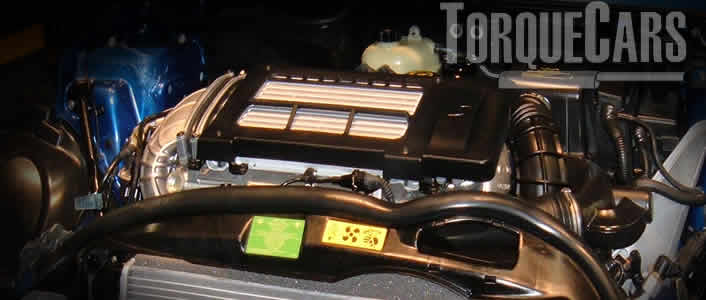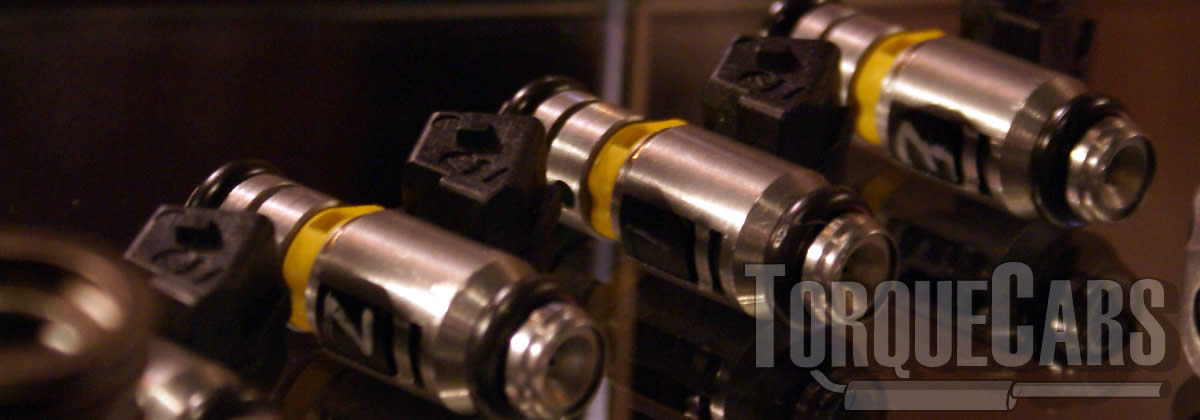Tuning the Mini Tritec
"Building the best modified Mini Tritec engine!"
Carref prides itself on providing the latest tips and guides to your modification project.
The Mini Tritec are good project engines and with the right upgrades like remaps, turbo kits and camshafts you will certainly maximize your driving opportunities.
Tritec motors was a collaborative effort from Chrysler, Rover which were part of the BMW group and the focus was to create a small straight 4 block suitable for the new MINI range.
The engine works really well with a supercharger, and the setup in the MINI Cooper is fantastic. It can still be improved though so now TorqueCars will review and look at Tritec tuning and outline the best mods that work.
Amazing the cast iron blocks can take quite a bit of power, and we've heard of a 600bhp tuned version of the Tritec. It was superceded by the Prince engine though N13 and N14.
We rely on our visitors to pass on tips and tell us about their projects and what worked on their car, and this article is the culmination of the feedback we have received. First let us look at the history and specs of this engine and then consider which tuning modifications work best on it.
History of the Engine
It came as a 1.4 or 1.6 and the 1.6 also had a Roots Eaton M45 supercharger fitted.
- 1.4(T14a)
74 hp 90 lbft Mini One (Portugal, Greece) (until 2008)
- 1.6(T16b3)
89 hp 103 lbft (Mini hatch)
114 hp 110 lbft (Cooper)
Chrysler Neon (in non-US markets)
Chrysler PT Cruiser - 1.6 SC(T16b4)
160 hp 150 lbft
168hp 160lbft
215hp 184lbft from 2006 JCW GP
What are the most effective Tritec mods
Just because particular tuning mods are are common on Tritec it doesn't mean its worth having, so we'll optimum tuning mods that will give your Tritec the biggest power gain return for your cash.
Altering your Tritec cam will make a dramatic difference to the engine bhp. Choosing a higher performance cam profile raises the bhp accordingly.

Fast road cams normally boost the performance through the rev range, you may sacrifice a little low down bhp but top end will be better.
Race cams, boost the top end band but as a result the car will not idle smoothly and low end power nearly always suffers.
For a car driven daily you need to optimize your engines power to your typical driving style.
I'd be shocked find a Tritec Competition cam is a pleasure to live with when on the daily commute.

Some Tritec engines respond better to different camshaft durations check your engine on a rolling road.
The engine timing and fuelling also have an effect on the bhp gains you'll achieve.
Altering valve durations can alter the bhp band and on most engines the exhaust and intake durations do not need to match, although most cams and tuners use matched pairs there are some advantages to extending the intake or exhaust durations.
Please watch our introduction Video tutorial to car tuning. Be sure to subscribe and support our new channel.
How to tune your car
- Improve the handling
Focus on Suspension improvements, such as coilovers and make sure the bushings are in good order and that the alignment is correct. Then focus on improving the brakes, with a big disk brake conversion kit and fast road brake pads.
- Remove restrictions
Focus on the intake and exhaust with filters being the common point of restriction in a tuned car. Intercoolers may also become restrictive on turbo engines so this may also need to be uprated.
- Burn more fuel & air
Increase the fuelling so it matches the air coming into the engine. The ratio is important so you need to improve the fuel pump and injectors, so the head mods, big valve conversions, fast road camshafts and forced induction upgrades extra supply of air is adequately met.
- Test and replace any weak parts
Weak areas are commonly the clutch, the turbocharger and pistons and crankshaft in a highly tuned engine. Makes sure these components will cope with your power aspirations.
- The Tune or Remap
A cars ECU controls the fuel, timing, spark and even the turbo in some cases, so to fully extract your gains you should remap the car last and this will fully release the power. Some cars are easy to map, and others require piggyback ECU's or aftermarket ECU's but this is the most vital step of your tuning project.
Modifying to Stage 1:
Panel air filters, Intake headers, Remaps/piggy back ECU, Sports exhaust manifold, Fast road camshaft, Drilled & smoothed airbox.
Modifying to Stage 2:
Fast road cam, fuel pump upgrades, induction kit, Sports catalyst & performance exhaust, high flow fuel injectors, Ported and polished head.
Modifying to Stage 3:
Twin charging conversions, Competition cam, Internal engine upgrades (head flowing porting/bigger valves), Adding or Upgrading forced induction (turbo/supercharger), Engine balancing & blueprinting, Crank and Piston upgrades to alter compression.
Remaps should help to to establish the full potential of all the parts you've done to your Tritec.
It will usually give around 30% more power on turbocharged vehicles and you can expect to see around 15% on NASP engines, but the end result usually vary depending on the parts you've applied and the condition of your engine.
It is the whole point to any engine upgrade project to force more air into the Tritec engine

Air Intake manifolds carry the air from the filter and allow it to be fed into the engine cylinders.
The bore size, shape and rate of flow of the Intake manifold can make a large difference to to fuel mixing and power on the Tritec.
We often see intake headers are in dire need of motorsport parts, although some manufacturers provide reasonably good intake headers.
Fitting big valve kits, carrying out port work and head flowing will also boost bhp and torque, & importantly will give you a greater bhp and torque increase on other upgrades.
Which turbo upgrades are best?

NASP engines need quite a lot of work when you add a turbo, so we have a separate guide to help you take into account the pros and cons of going this route on your Tritec
The more air you can get into an engine, the more fuel it can burn and uprating the induction with a turbocharger upgrade makes excellent power gains.
When the engine is turbo charged tuning parts are going to make more power and we find turbo charged engines are made using stronger components.
There are reliable limits for every engine, with some being over specified and some only able to handle stock power
It is important to find these limitations and install better pistons and crank to utilize the power.
It's not unheard of tuners spending a lot of money on turbo upgrades on the Tritec only to suffer the humiliation of seeing the engine block explode soon after it's been finished.
Bigger turbochargers tend to suffer a bottom end lag, and small turbochargers spool up really quickly but don't have the top end engines power gains.
Thanks to progress the range of turbos is always moving on and we commonly find variable vane turbos, permitting the vane angle is altered according to speed to lower lag and increase top end performance.
Twin scroll turbos divert the exhaust gases into two channels and feed these at differently designed vanes in the turbo charger. They also improve the scavenging effect of the engine.
It is common that there's a limit in the air flow sensor AFM/MAP on these engines when a lot more air is being pulled into the engine.
You'll see that 4 bar air sensors coping with quite large power gains, whereas the OEM air sensor was restricting torque at a much lower level.
Adding a supercharger or additional turbo will make large power gains, although more challenging to configure. We have a twincharger power adding guide if you want to read more.
Fuelling
When you improve the bhp you will need to increase to the fuel delivery.
More bhp needs more fuel. 
We strongly recommend you to over specify your injectors flow rate.
The accepted safe increase is to add 20% capacity when buying an injector, this accounts for injector deterioration and gives some spare capacity should the engine need more fuel.
We think this one is common sense, but you'll need to match your fuel injector to the type of fuel your car uses as well.
All the following flywheel power targets will assume an injector duty cycle of 80% and a base of 58psi of fuel pressure at idle.
4 Cylinder turbocharged engines
- 58 PSI 340cc/min 200hp
- 58 PSI 511cc/min 300hp
4 Cylinder NASP engines
- 58 PSI 285cc/min 200hp
- 58 PSI 426cc/min 300hp
4 Cylinder supercharged engines
- 58 PSI 312cc/min 200hp
- 58 PSI 468cc/min 300hp
Choosing the right performance exhaust
One of the most common mistakes and problems we see in tuning projects is usually down to the exhaust, or rather a poorly chosen exhaust for your engine.
You should look to replace your exhaust if the current exhaust is creating a flow problem.
On most factory exhausts you'll find the flow rate is still ok even on modest power gains, but when you start pushing up the power levels you will need to get a better flowing exhaust.
Sports exhausts increase the flow of air through the engine.
But if the exhaust is too big, ie: over 2.5 inches bore, you will lose a great deal of your flow rate and end up losing power and torque.
Usual exhaust restrictions are in the catalysts installed, so adding a higher flowing sports alternative will help avoid this restriction.
Weak spots Issues & problem areas on the
The engines are generally reliable and solid as long as they are regularly serviced and maintained.
The cast iron block and overall simple design make this engine particularly reliable, even when tuned.
Regular oil changes are vital on the , especially when tuned and will help extend the life and reliability of the engine.
For more information on Tuning your engine please join us in our friendly forum where you can discuss tuning options in more detail with our owners. It would also be worth reading our unbiased tuning articles to get a full grasp of the benefits and drawbacks of each modification.
Please help us improve these tips by sending us your feedback in the comments box below.
We love to hear what our visitors have got up to and which modifications work best for them on each model of car. Comments are used to improve the accuracy of these articles which are continually updated.
If you liked this page please share it with your friends, drop a link to it in your favourite forum or use the bookmarking options to save it to your social media profile.
Check out TorqueCars new YouTube channel, and see their awesome new content...
Feedback
Please use our forums if you wish to ask a tuning question, and please note we do not sell parts or services, we are just an online magazine.
Help us improve, leave a suggestion or tip
